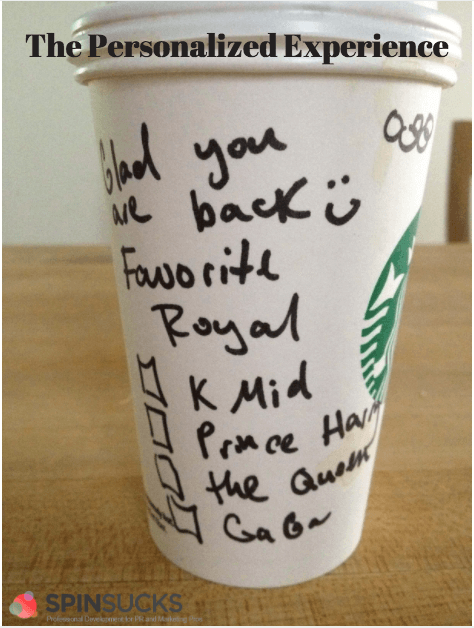 Four years ago (I can’t believe it’s been four years!), I wrote about my personal Starbucks experience with our barista, Dan.
Four years ago (I can’t believe it’s been four years!), I wrote about my personal Starbucks experience with our barista, Dan.
There are many independent coffee shops in our neighborhood—and we frequent them for other reasons (almond croissants, mmmmm!)—but for my morning latte? It’s Starbucks every day.
It’s not because they have the best coffee. In fact, most days I grimace through the first few sips of burnt coffee grounds.
Nor is it the closest (though I get more steps if I walk down there).
We go there every day because the experience is completely personalized.
I mean, who doesn’t love to be able to go to the front of a huge line because they’ve made your drink before you even walk in?
The only disadvantage to that is if you want to try something new or if you have friends with you…but, all-in-all, I love my very personalized experience there.
Our Attitudes Toward Data Sharing are Changing
As it turns out, I’m not the only person in this world who loves a personalized experience.
We all do!
New research from the State of the Connected Customer report shows customers’ attitudes about data sharing are changing.
And it’s because we love the personalized experience.
In fact, when evaluating purchases, we tend to give almost equal weight to a company’s personalization as we do to reputation.
In the research, 58 percent said a personalized experience is very important when purchasing from a company.
Compare that to 59 percent who say the same for buying from a well-respected or well-known brand.
Think about it, from a Starbucks experience.
Because I also have a gold card (free drinks!), they know what I buy every day.
Now they can personalize their offers to me.
They’d never send me a frappucino or bulk coffee offer. They only send me latte offers.
And I’m not alone in that thinking.
Most of us are very willing to hand over information about ourselves in exchange for personalized offers or discounts.
Additionally, consumers will share personal data in exchange for product recommendations that meet their needs (52 percent) and personalized shopping experiences (53 percent).
We also increasingly expect companies to anticipate the products we need next.
Yes Starbucks, as a matter of fact, I will need more coffee drinks in two weeks when family is here for Thanksgiving.
Thank you for anticipating that need and personalizing your communications around it.
But Collecting Data is a Real Challenge for Marketers
Still, collecting and leveraging customer data to deliver a truly personalized experience poses a challenge for many marketers.
To deliver the level of personalization the connected customer expects, marketers need more intelligent technologies.
The 2016 State of Marketing research revealed that many of these technologies are underused.
For instance, 49 percent of high-performing marketing teams say they extensively use predictive intelligence.
These tools, of course, make it much easier to track the data and use the insights to create a highly personalized experience.
But what if you’re not a consumer business that has a huge budget?
That’s great!
You have a better opportunity because your data is smaller, which is easier to harness.
As well, you can create a competitive edge by doing a few things differently.
The research shows the high-performing marketing teams do the following:
- Their organization empowers them to buy and use the right tools.
- They work closely with IT to develop apps and embed personalization.
- They embrace data-driver decisions to quickly adapt changing needs and perceptions.
The Personalized Experience is Easier Than You Think
If I think about my own business, the second one doesn’t make a lot of sense, but we can (and do) implement the first and third.
And, trust me, we do not have a huge operating budget.
The good news—and the huge opportunity—is we can all create a personalized experience for our customers, our donors, our volunteers, our brand ambassadors, our prospects, and our other invested stakeholders.
It just takes data, some software (which can start at the low, low price of free), and an executive team (or you!) to empower you to go for it.
Because the U.S. elections were yesterday and I want to write about that tomorrow, I’ll give you some thoughts next week on software and how to build your personalized experience program.
Until then, what do you think? Is this something you want to implement for 2017?